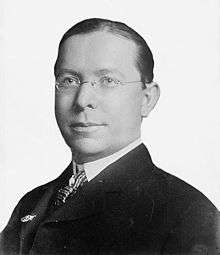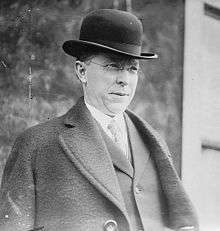Martin H. Glynn
| Martin Glynn | |
|---|---|
 George Grantham Bain Collection, Library of Congress | |
| 40th Governor of New York | |
|
In office October 17, 1913 – December 31, 1914 | |
| Lieutenant | Robert F. Wagner (Acting) |
| Preceded by | William Sulzer |
| Succeeded by | Charles S. Whitman |
| Lieutenant Governor of New York | |
|
In office January 1, 1913 – October 17, 1913 | |
| Governor | William Sulzer |
| Preceded by | Thomas F. Conway |
| Succeeded by | Robert F. Wagner |
| 39th Comptroller of New York | |
|
In office January 1, 1907 – December 31, 1908 | |
| Governor | Charles Evans Hughes |
| Preceded by | William C. Wilson |
| Succeeded by | Charles H. Gaus |
| Member of the U.S. House of Representatives from New York's 20th district | |
|
In office March 4, 1899 – March 3, 1901 | |
| Preceded by | George N. Southwick |
| Succeeded by | George N. Southwick |
| Personal details | |
| Born |
Martin Henry Glynn September 27, 1871 Valatie, New York, U.S. |
| Died |
December 14, 1924 (aged 53) Albany, New York, U.S. |
| Political party | Democratic |
| Spouse(s) | Mary McGrane |
| Education |
Fordham University (BA) Union University, New York (LLB) |
Martin Henry Glynn (September 27, 1871 – December 14, 1924) was an American politician. He was the 40th Governor of New York from 1913 to 1914, the first Irish American Roman Catholic head of government of what was then the most populated state of the United States.
Life
Glynn was born in the town of Kinderhook, N.Y., and grew up in one of Kinderhook's villages, the village of Valatie. He was the son of Martin Glynn (son of Martin Glynn and Catherine de Burke) and Ann Scanlon, who were both born in Ireland.[1]
He graduated from Fordham University in 1894,[2] then studied at Albany Law School of Union University, New York, and was admitted to the bar in 1897. From 1896 on, he wrote for the Albany Times-Union daily newspaper, becoming eventually its editor, publisher and owner. In 1898, Fordham awarded Glynn the honorary degree of master of arts.[3] Over the course of his career, Glynn received honorary LL.D. degrees from Fordham, Syracuse, Georgetown, and Union Universities.[3]

Glynn was elected as a Democrat to the 56th United States Congress, and served from March 4, 1899, to March 3, 1901. When he took his seat at age 26, Glynn was the youngest member of the House. He was New York State Comptroller from 1907 to 1908, elected in 1906, but defeated for re-election in 1908 by Republican Charles H. Gaus.
He was elected Lieutenant Governor of New York in 1912 on the ticket with William Sulzer, and succeeded to the governorship upon Sulzer's impeachment and removal from office in 1913. He was the first Catholic New York governor, but was defeated for re-election by Charles S. Whitman in 1914.
He was a delegate to the 1916 and 1924 Democratic National Conventions. As the keynote speaker at the 1916 National Democratic Convention, Glynn delivered one of his most famous speeches, praising the accomplishments of President Woodrow Wilson and the platform of the Democratic Party.
Martin Glynn was active in the Progressive movement and had an interest in Irish-American affairs.
Glynn committed suicide by gunshot in 1924, after having suffered throughout his adult life from chronic back pain caused by a spinal injury. Though the cause of death was listed on his death certificate, the local media reported that Glynn died of heart trouble.[4] The true story of his death was publicized in Dominick Lizzi's 1994 biography.[5][6] He was buried at the St. Agnes Cemetery in Menands, New York.[7]
"The Crucifixion of Jews Must Stop!"
Glynn's article "The Crucifixion of Jews Must Stop!" was published in the October 31, 1919, issue of The American Hebrew; in it he lamented the poor conditions for European Jews after World War I. Glynn referred to these conditions as a potential "holocaust" and asserted that "six million Jewish men and women are starving across the seas".[8][9][10] Robert N. Proctor says that "[this] oddity has been exploited by Holocaust deniers but is simply a remarkable coincidence and nothing more."[11]
Notes
- ↑ https://www.geni.com/people/Martin-Glynn/6000000013463979139
- ↑ Holmes, Frank R. (1924). Who's Who in New York City and State. 8. New York, NY: L. R. Hamersly Company. p. 513.
- 1 2 Who's Who in New York City and State, p. 513.
- ↑ "Ex-Gov. Glynn Dies Suddenly In Albany Home. Stricken With a Heart Attack After His Return From a Boston Sanitarium". New York Times. December 14, 1924. Retrieved 2014-08-01.
Former Governor Martin H. Glynn died in his home here today. Mr. Glynn returned yesterday from a hospital in the suburbs of Boston, where he had been under treatment during the last two months for spinal trouble of long standing. Members of his family said he complained last night of not feeling well, but attributed it to the trip
- ↑ Dominick C. Lizzi, Governor Martin H. Glynn, Forgotten Hero, Valatie Press. LOC Catalog Card Number:94-96495
- ↑ Paul Grondahl, Albany Times-Union, Big News, Small-Town Flavor: 1924 is a Turning Point Archived 2014-03-23 at the Wayback Machine., retrieved December 18, 2013
- ↑ Martin H. Glynn at Find a Grave
- ↑ html of complete text
- ↑ Image of the text
- ↑ reference to article in Jewish Virtual Library
- ↑ Proctor, Robert N. (2000). The Nazi War on Cancer. Princeton University Press. p. 11.
Sources
- Glynn Ill in Germany, May Decline Office; Comptroller-elect Suffering from Injury to His Spine, New York Times, November 9, 1906
- Martin H. Glynn Biography at Valatie, New York Library
- Martin H. Glynn at Political Graveyard (gives as birthplace Kinderhook, the town which includes the Village of Valatie)
- Martin Henry Glynn Papers, 1913-1924 at the New York State Library
| U.S. House of Representatives | ||
|---|---|---|
| Preceded by George N. Southwick |
Member of the U.S. House of Representatives from New York's 20th congressional district 1899–1901 |
Succeeded by George N. Southwick |
| Political offices | ||
| Preceded by William C. Wilson |
Comptroller of New York 1907–1908 |
Succeeded by Charles H. Gaus |
| Preceded by Thomas F. Conway |
Lieutenant Governor of New York 1913 |
Succeeded by Robert F. Wagner |
| Preceded by William Sulzer |
Governor of New York 1913–1914 |
Succeeded by Charles S. Whitman |
| Party political offices | ||
| Preceded by William Sulzer |
Democratic nominee for Governor of New York 1914 |
Succeeded by Samuel Seabury |
| Preceded by Alton B. Parker |
Keynote Speaker of the Democratic National Convention 1916 |
Succeeded by Homer Cummings |
